Transitioning Hairstyles for Natural Hair
The transition back from relaxed, chemical-treated hair to natural hair requires sheer dedication and commitment, regardless of whether you realize it or not. It frequently leaves your strands straight while maintaining the root’s curliness. Consequently, your hair might appear a bit odd when it’s down. At worst, it’s damaging for the hair as well.

So, long story short, styling transitioning hair is no easy task. Yet, you’d like more options for your natural phase during this phase than just a bun, right?
Well, you needn’t worry at all! You can fearlessly wear several hairstyles that could safeguard your scalp and hair over the long haul. And in this article, we’re going to share with you sixteen such quick and easy hairstyles for transitioning hair and how you can flaunt them flawlessly. So stick around.
Flexi-Rod Sets
This technique uses wet sets, such as flex-rods, magnetic rollers, perm rods, and curl-formers to blend your curly roots with the relaxed tresses. Because the size of the setting tools differs, you can customize the curliness of your finished style accordingly.
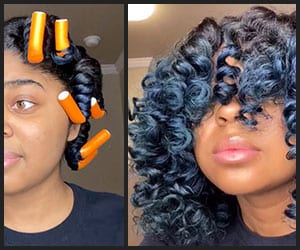
Start by separating your dry hair into sections and clipping it. Because they don’t depend on direct heat, wet sets are gentle. It’s also an excellent way to transition from straightened hair to textured hair, as you find a way to make the straightened hair match the new texture.
Then, using a spiral Flexi-rod, wind strands around the rod section-by-section after applying a hydrating mousse. As you curl the hair, fold the Flexi-rods’ ends inward to keep the hair in place. A twist-out is ideal for this type of careful styling. Twist sets don’t require holding the hair taut, and you can prevent tangling by working in sections.
After several hours, remove the Flexi-rods and use your fingers to separate the curls, and you’re all done.
Bantu Knots
Bantu knots are one of the most soothing short hairstyles for transitioning to natural hair. They keep the roots straight and smooth during sleep or work out, and the ends retain a nice curl without the need for lots of heat.

Similar to the wet sets, begin with clean, dry hair sectioned into the desired knot size. Then put any of your preferred hydrating products on the first section of hair to start creating the knots. From there, tie a two-strand twist or braid (see instructions at Two-Strand Twists).
You should then coil the twisted strand horizontally towards the scalp. In this way, you’ll get a taut, secure knot. Finally, pin the knot with a small bobby pin or fold the end underneath.
Cornrows
If you’re looking for utterly simple hairstyles for transitioning hair, cornrows are undoubtedly worth a try, especially if you’re already familiar with braiding. Here’s a rundown on a quick cornrow style.
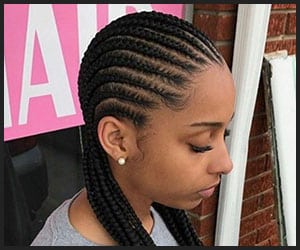
The first step is to blow-dry your hair until it’s perfectly stretched. Next, apply a leave-in conditioner to moisturize it well. Additionally, you can use a mousse or gel to enhance the hold. Then, seal in moisture from all the other products with a spritz of hair oil.
Using a similar technique to a French braid, you can hold the braids in place while wearing cornrows by picking up hair on the scalp. Then, on the scalp top, create two wide three-strand braids. While doing this, make sure you’re not applying excessive tension to your scalp while braiding.
Here’s another tip- if you enjoy rocking weaves or wigs to breeze through the hair transition process, you can style your hair in cornrows first before slipping something on.
Chignons/Buns
Bun hairstyles for transitioning hair are always accessible and elegant, and so are chignons and topknots. You’ll find this one easy to create, but be sure not to become too complacent: step away from this sleek style at least once a week. In this way, your hair around the edges is less likely to thin out.
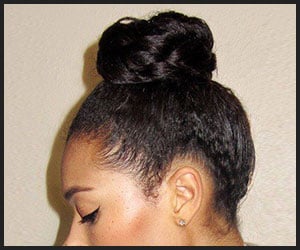
Use some gel or mousse to smooth down flyaways and create a high or low ponytail. Next, wrap your hair around to form the bun and then pin it down.
Then, you’ll want to take care of your edges with products like Cantu Extra Hold Edge Stay or Shea Moisture Jamaican Black Castor Oil Strengthen & Restore Edge Treatments, which are free of alcohol and help prevent your hair from drying out.
Sew-Ins
Some women find it easier to weave away their hair during the transition than to style it regularly. A sew-in hairstyle can be your BFF if you’re one of them.

For an idea of how your new texture will look on you, you can pick extensions that mimic natural hair. A qualified professional who is familiar with twists and braids can easily provide you with them. By wearing weaves correctly, you reduce the amount of time you have to deal with different textures during the growing-out phase.
Roller Sets
Another favorite way to reduce heat damage is to use a roller set. In transitioning from relaxed to natural hair, this method helps stretch the roots without excessive heat.

Immediately after washing your hair, apply a flexible mousse that has a soft hold. Afterward, place each section into a roller and allow it to sit for a few moments. For a faster result, you can blow-dry your hair. You can also choose to curl at any speed or direction you like using various rollers and rods.
Box Braids
Braided extensions rarely wear out when going to the gym, doing household chores, or backyard projects, and that’s why they are great for those with an active lifestyle. But on top of that, they act as an excellent protective style when transitioning to natural hair.
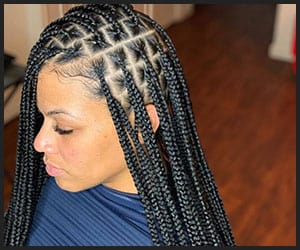
Understanding braid types is the first step. Box braids are loose individual braids, whereas, in a cornrow, hair is picked up from the scalp similarly to that of a French braid.
You may want to book an appointment with the salon for these styles because they require more time and expertise. Also, maintaining a healthy scalp and maintaining your hair with a curl moisturizer and oil is crucial while wearing any protective style.
Faux Locs
If you’re looking for some cool hairstyles for transitioning hair offering versatility with minimal effort, faux locks can be a fantastic option. Besides, they offer more freedom for a protective hairstyle compared to traditional braiding.

You can easily install these extensions yourself or have them installed at a salon. Just choose the lock you prefer and section your hair out. Then once you’ve attached the locks to your roots, weave them in until your natural hair is concealed.
Here’s one thing you must remember- after cleansing your hair, wrap it in a microfiber towel for about twenty minutes to soak up the excess water to prevent it from swelling up your roots, which could lead to damage.
Two-Strand Twists
Would you still consider bangs appropriate only for straight or wavy hair? Try these two-strand twisty bangs with your flat twists, and you’ll think differently.
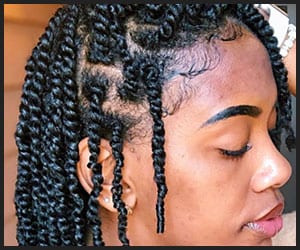
You can create this hairstyle on your wet hair using foam or curl cream. And many people prefer to wear them twisted or can unravel them after it has dried to reveal a curly set they can wear for a few days more, and you can do that too.
Straight hair makes this style seem unachievable to most new naturals. However, it’s possible to create the illusion of naturally curly hair by simply adding a small rod to each twist.
Braided Updo
Braided hairstyles for transitioning hair are a clever way to keep the tresses off your face while ensuring their protection. Here’s a quick method of a braided updo that you can wear using the cornrow technique we’ve already shown.
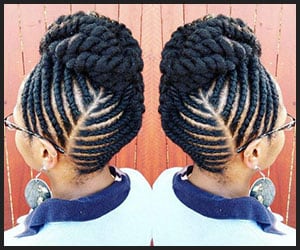
You can either braid the hair into cornrows along the same lines as the cornrow style or have your stylist do it for you. You can then twist and pin-up your braids into a high bun. While rocking this style, make sure you take care of the edges with the proper moisturization.
Jumbo Twists
If you haven’t had the big cut yet and don’t plan on getting one anytime soon, jumbo twists are a fantastic alternative for your long transitioning hair. Nevertheless, jumbo-sized Marley twists will also look stunning on chopped hair if you’re okay with extensions. We’ll show you how.
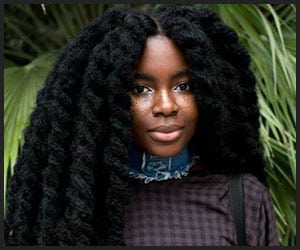
Start by cleansing and drying your hair. After that, section your hair to determine where you want the twists to be. Then, use the extension, fold it, then knot it onto the natural hair to create a two-strand twist. Lastly, using the Marley on both sides, create a two-strand twist.
Curlformers
Curlformers are yet another modern, heatless method of creating waves. It’s a wet-set style similar to Flexi-rods that flawlessly integrates your natural hair texture with your chemically altered hair. Here’s how you can do it.
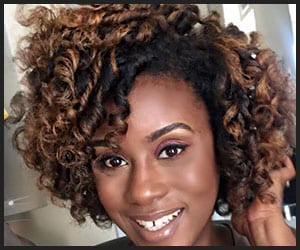
Take your Curlformers and the styling hook that came with them, and then put the first curl former onto the hook’s end. After that, take a reasonable portion of the hair and spritz it with water to dampen it. Remember, if the section is too broad, you’ll have difficulties applying the Curlformer, and if it’s too small, the curls will be too tight.
After you’ve dampened your hair, apply a leave-in conditioner and brush through to set it into the strands. Then twist the hair at the root and secure it with a hook. Now pull the style hook away from the root while pushing the Curlformer upward. By doing so, you are feeding the hair into the Curlformer.
When you’re holding the Curlformer at the root, pull it down, so the curl falls in place. You can then remove the Curlformer as soon as the hair has dried and separate the curls with your fingers. And voila, you’re done.
Pineapple Puff
Piling up your transitioning curls on your head top into a chic pineapple puff can be a quick and easy style you can opt for when in doubt.
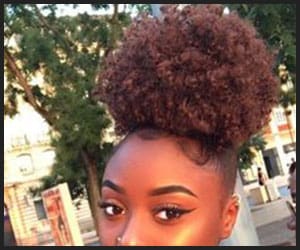
Simply brush a small amount of mousse into your hair and draw it back into an ultra-high ponytail, fastening with an elastic. Then apply a leave-in conditioner like Aunt Jackie’s Quench Moisture Intensive Leave-In Hair Conditioner for Natural Curls on the ends to moisturize them. If your curls aren’t overly defined yet, don’t worry; this style works well with wet sets too.
Banded Ponytail
Homemade banded ponytails are incredibly cute and easier to wear. The piggy tail with a crown braid is a popular hairstyle for young girls, which you can create effortlessly using the following technique.
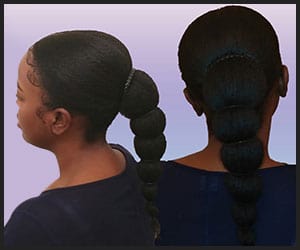
Prepare your curls by washing, drying, and hydrating them. Then section your hair evenly into two sections. Each section will need a band of elastic at the base of the scalp without the braids. To achieve the bubble effect, flow several elastics, three to four, depending on the length of your hair, down each ponytail.
Faux Ponytail
Are you looking for relatively straighter celebrity DIY hairstyles for transitioning hair? You may take a look at Keke Palmer’s pony. Unlike cornrows, twists, or box braids, this style takes a lot less effort and still looks fantastic. Faux ponytails are perfect for lazy days when you want to appear polished without putting in the work.

The style is particularly beneficial when dealing with multiple textures at the beginning of the transition phase. You can stop worrying about your hair getting tangled by simply pinning back your hair extensions and wearing a ponytail made from them.
Headband Wig
What if I told you it’s a wig? Well, believe it or not, it indeed is a wig. A headband wig offers complete protection and is one of the most comfortable, natural-looking transitional hairstyles available.
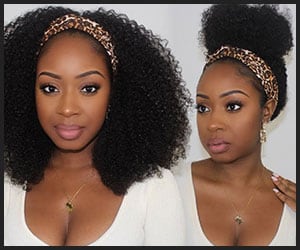
To ensure the wig construction doesn’t harm your natural hair, you must wear a stocking cap before creating this style. Then using the hairpiece as a headband, slide it over your hood and tie it in place. Following that, fluff out your curls as much as you can. You can also try adding an actual headband on your head top to create a creative, spiced-up look.
Thoughts
Transitioning to natural hair may not be the most appealing part of going naturally curly, but styling your hair during this phase shouldn’t be too challenging.
So, don’t be afraid to offer your hair some love. Hopefully, the transitioning hairstyles we’ve discussed above will make embracing your natural hair a lot less stressful, allowing you to take the world with complete confidence all along the way on your natural hair journey.
Related Posts
Sources
